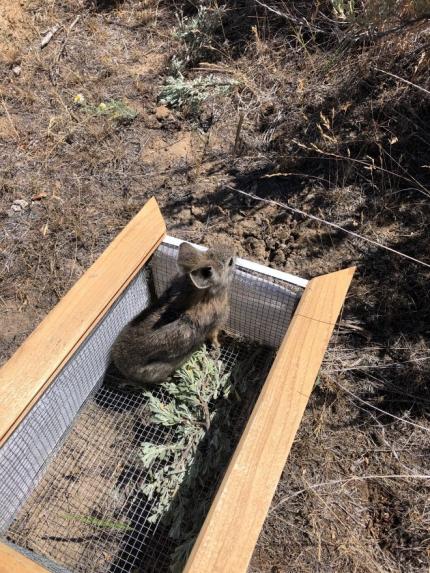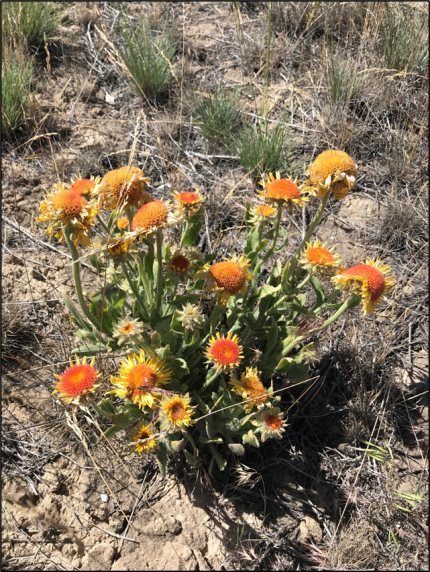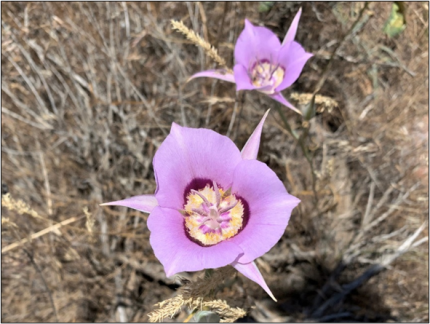Other
Northern Leopard Frogs: Biologist Grabowsky and the Northern leopard frog team have been hard at work to prepare for the upcoming Northern leopard frog (NLF) release that should occur within the next month. Our partners, Oregon Zoo and Northwest Trek, are currently caring for 450 tadpoles that are developing well. Technician Haines has been monitoring the wild site and the tadpoles appear to be developing at a similar rate to those in captivity. The NLF team has been hard at work preparing for releases this summer. A proposal has been approved to construct a bullfrog exclusion fence around our release site to identify the sources of mortality that our reintroduced frogs have been facing since 2019. This project will include tracking both NLF and bullfrogs via telemetry, completing behavioral studies, and performing visual encounter surveys. We hope this will answer some of our questions regarding the efficacy of the reintroduction site and allow us to improve the habitat for future releases.

Waterfowl: Biologists Dougherty and Clements and Technicians Gerstenberg and Kleinhenz have been preparing for banding season. This preparation began much earlier this year than in past years, due to increased staff capacity and starting the technicians earlier in the season. The first day of banding will be on July 1 and will continue through September. The early focus will be primarily on mourning doves and then quickly incorporate waterfowl trapping. With the additional staff capacity, we should well surpass past years’ banding efforts.
Additionally, all staff assisted Waterfowl Specialist Wilson to capture resident Canada geese as part of the ongoing banding and population monitoring efforts.

Grebes: Biologist Grabowsky has been monitoring artificial grebe nesting platforms over the past couple weeks. These nest platforms were constructed by Region 2 staff members and deployed at both Banks Lake and Potholes Reservoir where Clarke’s grebe and Western grebe activity tends to be high. Based on observations in June 2022, no grebes appear to be using these platforms for nesting. Grebe nesting activity in general seems to be relatively low compared to 2021 around the same time. No conclusion can be drawn from these observations yet and the platforms will be monitored throughout the summer. This project was implemented to investigate methods to mitigate effects on grebe nesting activity due to fluctuating water levels.


Wolverine Monitoring: Biologist Fitkin continued retrieving cameras deployed with scent attractants this past winter as part of the multi-state wolverine survey effort. This project is a repeat of a similar effort five years ago and is designed to detect trends in wolverine occupancy of modeled habitat in the western states. Unlike five years ago, the Rainy Pass site did not produce any wolverine detections this round, but other secondary target carnivores were detected.


Cougar Research: Biologists Fitkin and Heinlen as well as Research Scientist Kertson assisted some Canadian colleagues in locating the natal den of a cougar in District 6 that was radio-collared in British Columbia.
The young first-time mother had a primary and secondary den in shrubby draws otherwise embedded in a large tract of dry shrub-steppe. Unfortunately, we did not locate any kittens and it appeared, from the evidence on site, that they had been predated by a black bear(s). In fact, our group saw two black bears while searching for the den. In the past, Canadian biologists have followed up on a variety of our study animals that had dispersed north of the border, and it was gratifying to return the favor.







Wildlife Surveys: Biologist Cook assisted the pygmy rabbit crew with the trapping of kits for translocation.

Pygmy Rabbit Release Effort: Kit capture efforts continue this period and productivity is looking good for the enclosure breeding season. We have captured 81 kits thus far (already surpassing last year’s total of 70). We have released 43 juvenile rabbits into the new areas Rimrock Meadows and Palisades, 16 have been retained as future breeding stock, and 19 were too young to relocate and kept in their respective enclosure sites. Each juvenile is vaccinated against rabbit hemorrhagic fever (RHDV2). With above average spring precipitation and unusually cool temperatures, we are hoping this results in a sustained breeding effort.
Monitoring on the release sites is showing good results. The three Rimrock release/acclimation pens look to be doing very well. Rabbits are settling these sites and have begun to dig burrow sites. Rabbit activity and settlement is lower on the three Palisades release sites. We have set up several remote cameras at these sites to get an idea of what they are doing after release.


Canada Goose Banding: Science Technician Pavelchek joined State Waterfowl Specialist Wilson and other WDFW biologists to capture and mark Canada geese in several locations across Douglas County, including Rock Island Golf Course, Daroga State Park, and Lake Chelan.
WDFW uses the information collected from hunters who harvest marked geese and birdwatchers who report sightings of marked geese to increase their understanding of the movements of geese relative to urban areas and hunting areas. Waterfowl hunters are asked to report leg band information if they harvest a marked goose. The highly visible collars can be reported by any observer. Reports of band or collar codes, along with locations and dates, should be made to the U.S. Geological Survey Bird Banding Laboratory.


Bumble Bees: Biologist Jeffreys and Scientific Technician Pavelchek conducted bumble bee surveys at Refrigerator Harbor on the shore of Lake Chelan by Lucerne. Although many plants were still flowering, only one bumble bee was observed in the survey grid. This bee was captured and identified as a yellow-faced bumble bee (Bombus vosnesenskii). Habitat data was collected for the grid including identifying and photographing flowering plant (food source) species. This disappointing lack of bumble bees was not limited to the area within the survey grid. Pavelchek and Jeffreys observed only a couple of bees in the surrounding area throughout the duration of their stay. US Forest Service volunteers staying at the Lucerne guard station noted that they had seen very few bumble bees there this year as well.
Despite the underwhelming results, the data collected from this survey were entered into the Pacific Northwest Bumble Bee Atlas online database. The PNW Bumble Bee Atlas is a collaborative effort between WDFW, Idaho Department of Fish and Game, Oregon Department of Fish and Wildlife, and the Xerces Society for Invertebrate Conservation to track and conserve the bumble bees of Washington, Idaho, and Oregon.
Biologists Dougherty and Clements took some time to conduct bumble bee surveys as part of the Pacific Northwest Bumble Bee Atlas and surveyed high priority grids near Ritzville.
Despite lots of flowering resources, biologists were only able to capture one bumble bee.


Common Loons: Scientific Technician Pavelchek and Biologist Jeffreys hiked from the Refrigerator Harbor campground at Lucerne up to Domke Lake to follow up on a report from a local that common loons had been breeding at that lake for decades, and had raised young again in the summer of 2021.
This was exciting information as common loons, a WDFW Priority Species and Species of Greatest Conservation Need, have not been documented as breeding in Chelan County for many years. Upon arrival at the lake, Pavelchek and Jeffreys immediately spotted a pair of adult loons foraging very close together.
However, despite prolonged viewing through binoculars and spotting scope, no chicks were observed on or with the adults. At this point in the breeding season, loons that nested successfully would not be moving around the lake without their young, so it is likely that either this pair did not breed or they did breed but the nest failed. There are many potential causes for nest failure including predation, which seems especially likely given the presence of a bald eagle family nesting right on the south shore of the lake.
In an attempt to locate a nest and hopefully gain some insight into whether or not this loon pair did breed but were simply unsuccessful, Jeffreys and Pavelchek boated the entire shoreline of Domke Lake. Much of the shoreline appeared to offer optimal common loon nesting habitat, with plenty of emergent vegetation and many sheltered areas. No obvious nest was found, but it very likely could have been hidden from surveyors’ view. Future years’ surveys for breeding common loons in Chelan County will include Domke Lake.


Bat Monitoring: Biologist Jeffreys and Technician Pavelchek deployed four SM4 acoustic detectors at Burch Mountain and in Swakane Canyon as part of a joint effort between WDFW, Northwestern Bat Hub at Oregon State University, and other regional partners. SM4 acoustic detectors record the high frequency vocalizations of bats, allowing for call analysis and species identification. These data will be incorporated into the North American Bat Monitoring Program, which seeks to monitor local and regional bat population trends across the continent and inform effective bat conservation efforts.
Additionally, Jeffreys and Pavelchek conducted an emergence count from some bat boxes in Cole’s Corner, determining that a colony of big brown bats (Eptescus fuscus) occupied one box, and a smaller species, likely little brown myotis (Myotis lucifugus), and/or Yuma myotis (Myotis yumanensis), occupied another.
These sites may be used as part of WDFW’s ongoing white-nose syndrome monitoring effort in the future.

Providing Conflict Prevention and Education
Addressing Deer and Elk Damage: Specialist Bridges continues to work with a multitude of landowners in assisting with attempts to decrease damage from deer and elk.
Deer Exclusion Fence: Specialist Bridges has spent a considerable amount of time working with a landowner to construct a 4-acre fence on the edge of town. As wildlife habitat continues to decrease, there will be an increase of deer needing to winter on private lands where they are tolerated.
Nuisance Bear Response: Specialist Bridges assisted Enforcement, while responding to a landowner experiencing acute bear conflicts.
Reducing Conflict: Specialist Bridges has spent a considerable amount of time working with the City of Leavenworth and various non-government organizations, coordinating an effort to fence off garbage dumpsters which are a continuous source of attractants for bears.
Domestic Sheep Fencing Project: Specialist Bridges has been working the last four months to address domestic and big horn sheep disease concerns by working with a private landowner, the Wild Sheep Foundation, and the Asotin County Conservation District. Work will begin soon and will result in the construction of a fence to reduce the potential for disease transfer from domestic sheep to wild big horn sheep.
Conserving Natural Landscapes
SAFE-CRP: Biologist Morris met with a landowner and started evaluating fields for a SAFE-CRP re-enrollment. He conducted field visits to assess the quality of the fields, presence of weeds, and value for wildlife/shrub steppe habitat. Biologist Morris will use this information to write a plan for management of these fields.



Lands 20/20: Lands Operations Manager Finger wrapped up Lands 20/20 proposals for Douglas and Grant counties. Douglas County proposals included a Phase 4 of Big Bend Wildlife Area which could add up to 4,063 acres for additional conservation habitat to benefit Columbian sharp-tail grouse from two different landowners on the western side of the Big Bend Wildlife Area.
Additionally, a proposal was submitted to acquire several inholdings in the West Foster Creek area with remaining Recreation and Conservation (RCO) funds from the original Big Bend acquisition. For Grant County, Finger submitted a proposal to address legal access issues to about 15 parking areas on Columbia Basin Wildlife Area. Historically, public use of farm roads was supported or at least tolerated. In recent years, that access has been in decline.
Finger submitted a proposal for Columbia Basin Wildlife Area inholdings which are perhaps best categorized by three categories:
- Traditional inholdings which threaten to impact mule deer habitat in the Desert Unit (GMU290).
- Properties existing between county roads and wildlife areas with potential for habitat encroachment and disturbance impacts.
- Properties which bisect heavily used trail systems and intact habitat, with risks to both recreation and habitat connectivity.
Finger also continued information gathering for the next round of Lands 20/20. Proposals will likely move forward for the properties in the Beezley Hills of Grant County, which are very important for pygmy rabbit conservation, and in the White River Unit of Chelan Wildlife Area, where there may be potential to receive Priest Rapids Coordinating Committee funds for an appraisal, then potentially acquisition to acquire lands with significant potential for salmon restoration projects.


Providing Education and Outreach
Responding to Hunter Calls: Specialist Bridges has been responding to calls from successful special permit holders for the Peshastin and Malaga hunts.
Other
New Assistant District Biologists: District 5 welcomed the new Assistant District Biologist Clements. Biologist Clements joins us from the WDFW pygmy rabbit team where she worked as a scientific technician. She brings important game and nongame wildlife experience to the team, extensive experience working within the Columbia Basin, and enthusiasm to make the most out of this position. Welcome Biologist Clements!
We would also like to welcome Johnna Eilers to the WDFW team as the new assistant district wildlife biologist for District 7. She brings with her a diverse background from teaching Ornithology and Mammalogy labs at Washington State University as well as from her five seasons as a wildlife technician with Utah Division of Wildlife working with birds, bats, pika, prairie dogs, and native fish. She is excited to have the opportunity to work with game species and looks forward to tackling issues and questions relating to harvest and game management.
Meetings: Biologist Morris attended a Pheasants Forever board meeting with the Big Bend Pheasants Forever chapter. He met the recently hired Pheasants Forever private lands biologist, who is working out of the Natural Resources Conservation Service office in Ephrata. He also coordinated with the chapter on potential habitat projects. This valuable relationship facilitates for numerous habitat restoration projects with private funding to match state and federal funds to increase the capacity for projects.